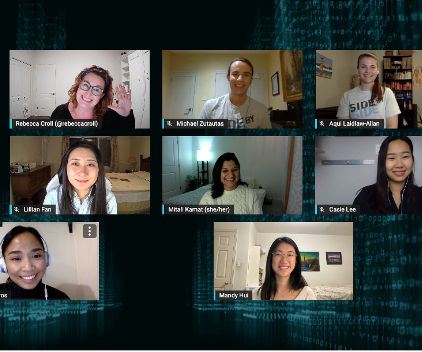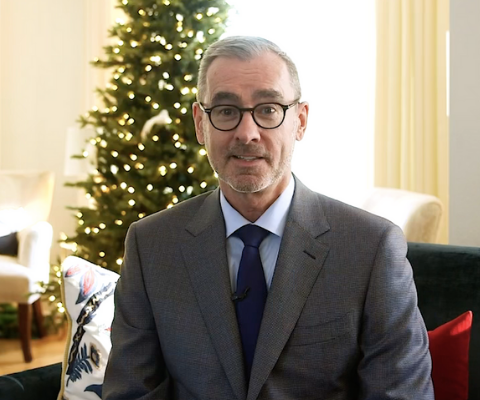Convergences 2016 : Les États-Unis et le défi énergétique mondial
Text on screen: [Mindshare logo, Inspired thinking on the future of energy]
Text on screen: [Science and Technology for the Energy Challenge, a U.S. Perspective]
Text on screen: [Thom Mason, Director, Oak Ridge National Laboratory, Oak Ridge Tennessee]
Thom Mason: Well, having heard a social sciences perspective and a science-and-technology policy perspective, and an economics perspective on the energy challenge, I think it’s appropriate to now turn our attention to the underlying science and technology. And the reason is because it turns out we have a lot of work to do.
Now, I’m – I would characterize myself as a technological optimist. I think there’s a lot can be done to improve things. But it’s im—the reason that we have a lot of work to do is because this is an over-constrained problem. And I put down my four favourite constraints on this slide. You may find it a little bit odd that I would say we don’t have all the science and technology we need to solve this problem, given that on any given day you will find someone who tells you that they have the solution. Typically it’s what they’re selling, whether that be in the form of a product or a start-up company or a researcher who has a particular area of expertise. And what they usually mean when they say I have the solution is they can solve one or perhaps two of these problems.
But this is a tricky thing because we have multiple constraints in different directions, and you’ve heard about most of them already. There are the concerns about the environmental impacts of energy production, distribution, and use, whether that’s local environmental impacts in the form of air quality or global environmental impacts in the form of CO2 emissions and climate change. There are national and global security implications of energy scarcity. The example of Ukraine was already mentioned in Europe. There are economic consequences of energy prices, both upside and downside. You see money sloshing around around the world as oil prices go up and down. And you still of course have a final problem, which is partly economic, which is energy access in developing nations. There are billions of people today who don’t have access to energy, don’t have access to electricity, and don’t have access to the standards of living and quality of life that we enjoy in the developed world.
As I said, there are technological solutions to any one of those four, and in some cases maybe two, maybe in a very few cases three. But I would argue that we don’t have the whole package solution yet, and it’s not going to be a single-point solution.
So climate change is probably the trickiest to deal with because of the fact that it’s delocalized. So there’s not that kind of automatic feedback between the citizen of Beijing taking a picture with their camera and the immediate impacts of energy production from a coal-fired plant that’s not too far away. It’s also a little bit remote, given the time scale that it unfolds on. You know, the – we will often be prone to wonder whether or not the glorious weather in Edmonton today is due to climate change, and perhaps it is and perhaps it isn’t. No particular weather event, you know, has a direct linkage. In fact, the more accurate representation is the vague memory that it snowed more when we were kids. And that’s a little hard to quantify. But the interconnected risks associated with it are substantial. There’s economic risks, rising sea level, not so much a big deal here, but if you’re in Florida you might be concerned. The extreme weather and wildfires that have increased – and this is something which you can measure well by thinking about the re-insurance industry that worries about insuring these large risks. And actually, the fact that you see an awful lot of hundred-year events in the last ten years is kind of indicative of that. Impacts on agricultural production and energy demand, and then temperature impacts on productivity and health.
There are – there are health impacts associated with climate change, with heat-related illnesses, air quality, water scarcity, disruptions in water supply, climate-linked disease. Things like concerns that we’ll be hearing a lot about this summer with the Zika virus have underneath them the propagation of particular mosquito species further and further north. And then the security impacts: social unrest driven by rising food prices. The Arab Spring, if you remember how that started was associated with food vendors in Tunisia. And so there’s a little bit going on there that can tie back actually to climate change. Forced migration. There are a lot of vulnerable populations in low-lying levels – low – in levels that are close to sea level, in places like India and China, and, as I mentioned, Florida. We don’t want everyone in Florida moving to Tennessee. That would probably cause social unrest.
(Laughter)
And water supply conflicts, which, you know, could become interesting even between the US and Canada at some point in time. And finally, Arctic territorial disputes that are driven by the fact that, as sea ice dissipates, you have access to natural resources that are sort of attractive that really weren’t on the table before.
So in order to tackle these problems, as I said, you’re going to need better science and technology solutions, and it really is, as has been pointed out, something of a transformation of the global energy system that will be required. And it turns out there are a number of different elements. We actually looked at this in some detail a couple of years ago, breaking it down into energy efficiency; transportation; buildings; manufacturing and the grid; electrification of transportation since, you know, it’s hard to sequester all the tailpipe emissions; increased use of renewable energy, biofuels, and bio-products; advanced liquid fuels from fossil resources; carbon management; and next-generation nuclear power. And all of those have underneath them challenges in terms of the available technology, challenges where we need to reduce cost, we may need to deal with social acceptance and safety concerns. There are just practicalities associated with intermittency of renewables. There are potential technical solutions to most of these challenges, but they are not all in hand, and we do need some basic advances in science and supporting technology in order to get to a point where that interconnected set of energy sources, distribution techniques, and improvements in end use could simultaneously solve all four of those constraints that I talked about.
Now, this is something that’s actually going to require fairly close coupling of, you know, fairly fundamental research in terms of our understanding of materials, our understanding of biological systems, our understanding of nuclear science and technology, and their end-use application in some sort of cost-effective, manufacturable product. And we like to think about this nice linear flow from fundamental research to an end product. In fact, the Department of Defense in the US has systematized it into 6.1, 6.2, 6.3, 6.4. These are actually different parts of the DOD budget. And so there’s this idea that you have a technology readiness level and a nice, orderly way you march down the path from the fundamental discovery to a widget. You know, so out pops GPS at the end of the innovation chain. This is a great theory. It’s good for explaining things to people. It bears no resemblance to what actually happens.
(Laughter)
There are new discoveries that are unexpected that may enable some kind of new product. You run into problems when you have to go back to the drawing board and tap into that basic science understanding to solve them. So are all – there are all these eddies and turbulent flow along that, you know, nice model where you go from discovery to developing new processes to fabricating prototypes and eventual optimization and deployment, all sorts of back and forth.
I run a national lab, which is a great privilege because national labs kind of sit in an interesting space along that chain. We work a lot with universities, doing a lot of important fundamental research, and we also work handing off to industry. And so we occupy some of that white space between the two because we’re a mission-driven entity. Unlike universities, which tend to be very fertile ground for kind of the bottoms-up innovation of individual faculties and members and so forth, we can actually more or less occasionally tell people what to do and put them into big teams to go and solve big problems with a particular outcome in mind. And that was very much part of the creation of national labs, which kind of grew out of the Manhattan Project, where we had a big, important problem to solve and we had to tap into the best expertise in academia and industry in order to solve it, and it’s still part of the way we work today.
So as I – I’ve hopefully made a little bit of the case that we need some advances in science and technology, but we also need new means of translating that innovation into practice. And we need better decision tools for policy makers to understand if I make this change in, you know, environmental law, if I make this change in the policy around how utilities operate, what will it do. And it’s a complicated system. So we need new partnerships to bring together the various stakeholders.
And this is one example to illustrate what I mean. This is something that we rolled out last September called AMIE, which stands for Additive Manufacturing Integrated Energy. So it was an effort to pull together some of the things we’d been working on at the lab in terms of new technologies, like the development of low-cost carbon fibre, which will be making important contributions to achieving energy efficiency goals for the automotive fleet. The CAFE standards that actually drive energy efficiency for vehicles in the US, and really more broadly, are pushing towards 55 miles per gallon by 2025. A big component of that is light-weighting, and carbon fibre is a great, high-performance material. It’s very strong. You would say it solves the problem. However, remember there’s the four constraints. It’s pretty darned expensive, so it’s fine if you want to get a pair of really fancy skis, or you’re building a stealth bomber and cost is no object. But if you’re trying to sell cars for $20,000 a pop, then carbon fibre doesn’t work. So we’re working on low-cost carbon fibre. We’re working on additive manufacturing to actually cost-effectively incorporate that carbon fibre into vehicles, but also into things like 3D printing of power electronics, heat sinks. We’re working on energy transfer, wireless charging of electric vehicles, two-way energy transfer.
And actually, AMIE was an effort to bring all these things together to kind of explore the world of the possible for distributed energy. So what you see in the photograph there is a 3D printed PUV, Printed Utility Vehicle, printed out of carbon fibre-reinforced plastic. It’s actually basically the same plastic in Lego, but with chopped-up carbon fibres in it to give it the strength it needs. It has a natural gas-powered electrical generator, and a battery. It has wireless power transfer, bidirectional power transfer, to the 3D printed home which is beside it, which also has a repurposed vehicle battery as a storage mechanism and photovoltaics on the roof, and then a smart system that connects these things all together so that, when the sun is shining, you’re generating electricity for use in the home, and also to recharge the batteries – either ones: the batteries in the home or the batteries in the car. You can use those batteries when the sun is not shining. If the sun is not shining for an extended period of time, you can actually use the car to power the house. And all these things need to work together.
And so in order to pull this off – and we did it in less than a year – we had to form partnerships with academic institutions and with companies from all over the country. And you can see some of the logos there. So SOM, for example, is Skidmore, Owings and Merrill, a quite famous Chicago architectural firm who helped with the design of the house. We’ve got Alcoa, who helped us with the windows. In order to reduce the energy demand to the point where this is practical, you’ve got to have good insulation. Companies like Clayton Homes, which is the largest manufacturer of fabricated homes in the US, and so forth. And pulled together this team in order to, as I said, really demonstrate the art of the possible. And of course at the end of the day you tend to solve the really tough problems when you have to, so it’s a good idea to actually have a specific goal and a date in mind in order to get there. So that’s just one example out of many.
The final thing I wanted to talk a little bit about was this thing called Mission Innovation because both Canada and the US have signed up for that. And it was announced in Paris, and it’s important to understand why Mission Innovation was announced. The commitments that were made in Paris were an important step to tackling the problem of climate change and CO2 emissions, but actually, unfortunately, fall far short of what is actually needed to solve the problem. So on the one hand, we may be sceptical about whether or not we’re going to even achieve those targets, and so that’s a concern. But even if we get there, it’s not enough to avoid carbon emissions on a scale that would lead to pretty significant changes that would have economic, social, and global stability –
Text on screen: [Mindshare logo, Inspired thinking on the future of energy]
Thomas Mason, directeur du laboratoire national Oak Ridge du ministère de l’Énergie des États-Unis, examine les aspects scientifique et technologique du défi énergétique mondial.
Vidéo et transcription disponibles en anglais seulement
Catégorie : Recherche et innovation




